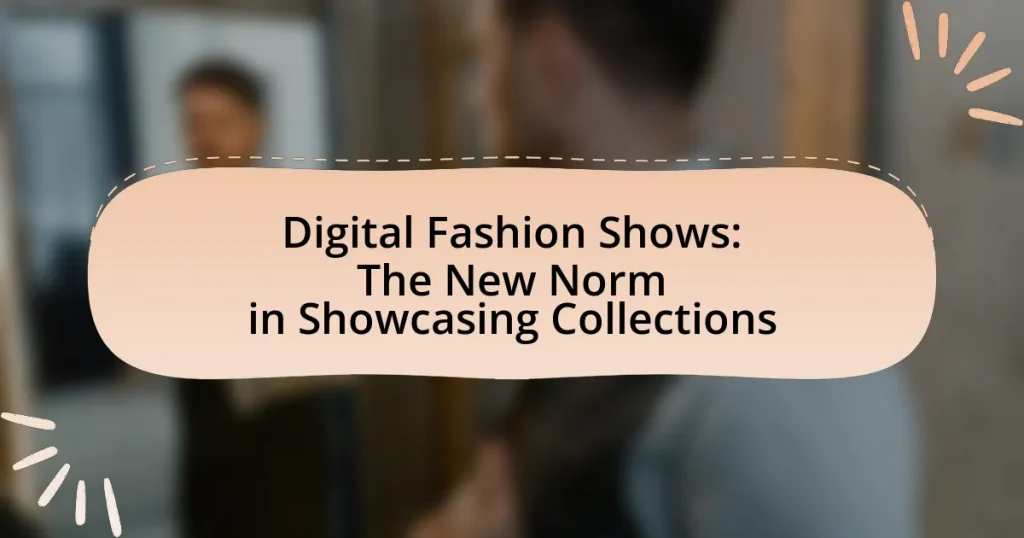Digital fashion shows represent a transformative shift in the fashion industry, utilizing virtual platforms to showcase collections through technologies such as 3D modeling, augmented reality, and live streaming. Unlike traditional fashion shows, which are often exclusive and limited by physical space, digital formats allow for broader accessibility and engagement with global audiences. The COVID-19 pandemic has accelerated this trend, prompting brands to adapt to online presentations, resulting in increased viewer participation and innovative storytelling. This article explores the differences between digital and traditional fashion shows, the technologies employed, audience engagement strategies, and the challenges faced, while also highlighting the future trends and best practices for successful digital showcases.

What are Digital Fashion Shows?
Digital fashion shows are virtual events where designers showcase their collections using digital platforms instead of traditional physical runways. These shows utilize technology such as 3D modeling, augmented reality, and live streaming to present garments, allowing for broader accessibility and engagement with global audiences. The rise of digital fashion shows has been accelerated by the COVID-19 pandemic, which prompted many brands to adapt to online formats, exemplified by events like the digital Paris Fashion Week in 2020 that attracted millions of viewers worldwide.
How do Digital Fashion Shows differ from traditional fashion shows?
Digital fashion shows differ from traditional fashion shows primarily in their format and accessibility. Traditional fashion shows are live events held in physical venues, often exclusive to industry insiders, while digital fashion shows utilize online platforms to reach a global audience, allowing anyone with internet access to view the collections. This shift has been accelerated by advancements in technology and the need for brands to adapt to changing consumer behaviors, particularly during the COVID-19 pandemic, which saw a significant rise in virtual events. According to a report by McKinsey & Company, the fashion industry experienced a 93% increase in digital engagement during this period, highlighting the effectiveness and growing importance of digital formats in showcasing collections.
What technologies are utilized in Digital Fashion Shows?
Digital fashion shows utilize technologies such as virtual reality (VR), augmented reality (AR), 3D modeling, live streaming, and artificial intelligence (AI). VR creates immersive environments for viewers, while AR enhances the experience by overlaying digital elements onto the physical world. 3D modeling allows designers to visualize garments in a digital space before production. Live streaming enables real-time access to shows for a global audience, and AI can analyze viewer preferences to tailor experiences. These technologies collectively transform how fashion collections are showcased, making them more accessible and engaging.
How do audience engagement strategies vary in Digital Fashion Shows?
Audience engagement strategies in digital fashion shows vary significantly from traditional formats by leveraging interactive technologies and social media platforms. Digital fashion shows often incorporate live streaming, allowing real-time audience participation through comments and reactions, which enhances viewer involvement compared to static presentations. Additionally, brands utilize augmented reality (AR) and virtual reality (VR) to create immersive experiences, enabling audiences to visualize garments in a more engaging manner. For instance, brands like Balenciaga and Gucci have successfully integrated these technologies, resulting in increased viewer retention and interaction rates. Furthermore, social media campaigns surrounding digital shows encourage audience sharing and user-generated content, fostering a community atmosphere that traditional shows typically lack. This shift towards digital engagement reflects a broader trend in the fashion industry, where brands aim to create more personalized and interactive experiences for their audiences.
Why are Digital Fashion Shows becoming popular?
Digital fashion shows are becoming popular due to their ability to reach a global audience and provide immersive experiences. Traditional fashion shows are often limited by physical space and attendance, whereas digital formats allow brands to showcase collections to millions online, breaking geographical barriers. For instance, the 2021 Paris Fashion Week featured numerous digital presentations, attracting over 1.5 million viewers, highlighting the significant reach and engagement potential of digital formats. Additionally, digital fashion shows enable innovative storytelling through technology, such as augmented reality and interactive elements, enhancing viewer engagement and creating memorable experiences.
What impact has the COVID-19 pandemic had on the rise of Digital Fashion Shows?
The COVID-19 pandemic significantly accelerated the rise of Digital Fashion Shows by forcing the fashion industry to adapt to social distancing measures and restrictions on in-person gatherings. As traditional runway shows were canceled or postponed, brands turned to digital platforms to showcase their collections, leading to an increase in virtual presentations. According to a report by McKinsey & Company, 75% of fashion executives indicated that the pandemic would accelerate the shift towards digital channels, highlighting a permanent change in how fashion is presented. This shift not only allowed brands to reach a global audience but also fostered innovation in digital storytelling and engagement, making Digital Fashion Shows a new norm in the industry.
How do Digital Fashion Shows cater to a global audience?
Digital Fashion Shows cater to a global audience by utilizing online platforms that allow viewers from various geographical locations to access the shows in real-time. These shows often feature live streaming, enabling participation from diverse time zones, and are frequently accompanied by interactive elements such as social media engagement and virtual reality experiences. For instance, major fashion brands like Balenciaga and Gucci have successfully hosted digital shows that attracted millions of viewers worldwide, demonstrating the effectiveness of this format in reaching a broad audience. Additionally, the use of multiple languages in commentary and subtitles further enhances accessibility, ensuring that non-English speaking audiences can engage with the content.

What are the advantages of Digital Fashion Shows?
Digital fashion shows offer several advantages, including increased accessibility, cost-effectiveness, and enhanced audience engagement. Increased accessibility allows a global audience to view collections without geographical limitations, as digital platforms can reach millions simultaneously. Cost-effectiveness is evident in reduced expenses related to venue rental, travel, and physical production, enabling brands to allocate resources more efficiently. Enhanced audience engagement is achieved through interactive features, such as live chats and social media integration, which foster real-time communication between designers and viewers. These advantages collectively position digital fashion shows as a transformative approach in the fashion industry.
How do Digital Fashion Shows enhance accessibility for designers and audiences?
Digital fashion shows enhance accessibility for designers and audiences by eliminating geographical barriers and reducing costs associated with traditional runway events. Designers can showcase their collections to a global audience without the need for physical venues, travel, or extensive logistics, which often limit participation. For instance, platforms like Instagram Live and virtual reality environments allow designers to reach viewers worldwide, increasing visibility and engagement. Additionally, audiences can access these shows from their devices at their convenience, making fashion more inclusive. This shift has been supported by the rise of online viewership, with reports indicating that digital shows can attract millions of viewers, significantly surpassing the attendance of physical shows.
What cost savings can be achieved through Digital Fashion Shows?
Digital fashion shows can achieve significant cost savings by eliminating expenses associated with physical venues, travel, and logistics. Traditional fashion shows often incur high costs for venue rental, set design, and transportation of models and equipment, which can total tens of thousands of dollars. In contrast, digital fashion shows utilize virtual platforms that require minimal overhead, allowing brands to allocate resources more efficiently. For instance, a study by McKinsey & Company found that brands can reduce their marketing budgets by up to 30% when transitioning to digital formats, as they can reach a global audience without the geographical constraints of physical events.
How do Digital Fashion Shows allow for creative expression?
Digital fashion shows allow for creative expression by providing designers with a platform to showcase their collections in innovative and unrestricted ways. Unlike traditional runway shows, digital formats enable the integration of multimedia elements, such as animation, virtual reality, and interactive features, which enhance storytelling and visual impact. For instance, designers can create immersive environments that reflect their artistic vision, allowing for a more profound connection with the audience. This flexibility fosters experimentation with aesthetics and presentation styles, as seen in events like the Balenciaga Fall 2021 show, which utilized a virtual setting to convey a unique narrative. Thus, digital fashion shows expand the boundaries of creativity in the fashion industry.
What challenges do Digital Fashion Shows face?
Digital Fashion Shows face several challenges, including technological limitations, audience engagement, and brand representation. Technological limitations can hinder the quality of the presentation, as issues like bandwidth and platform compatibility may affect the viewing experience. Audience engagement is another significant challenge, as digital formats often struggle to replicate the immersive experience of physical shows, leading to lower viewer retention rates. Additionally, brand representation can be compromised, as the lack of physical presence may dilute the emotional connection between the audience and the brand, making it harder to convey the intended message and aesthetic. These challenges highlight the complexities of transitioning from traditional to digital formats in the fashion industry.
How do technical issues impact the success of Digital Fashion Shows?
Technical issues significantly hinder the success of Digital Fashion Shows by disrupting the viewing experience and diminishing audience engagement. For instance, problems such as poor video quality, lagging streams, or audio malfunctions can lead to viewer frustration and disengagement, ultimately affecting brand perception and sales. A study by the Fashion Institute of Technology found that 70% of viewers reported a negative experience due to technical glitches during online events, highlighting the critical need for robust technology infrastructure. Therefore, the presence of technical issues can directly correlate with lower viewer retention and reduced effectiveness of the fashion showcase.
What are the limitations of audience interaction in Digital Fashion Shows?
The limitations of audience interaction in Digital Fashion Shows include reduced real-time engagement, lack of physical presence, and limited sensory experiences. Digital formats often restrict immediate feedback and interaction that occurs in traditional shows, where audiences can react and influence the atmosphere. Additionally, the absence of a physical environment diminishes the emotional connection and immersive experience that attendees typically enjoy, as they cannot physically interact with the garments or the models. Furthermore, sensory elements such as touch, smell, and the ambiance of a live event are absent in digital formats, which can lead to a less impactful experience for the audience.

How are brands adapting to Digital Fashion Shows?
Brands are adapting to digital fashion shows by leveraging technology to create immersive and interactive experiences for their audiences. This adaptation includes utilizing virtual reality and augmented reality to enhance viewer engagement, as seen in brands like Balenciaga and Gucci, which have hosted fully digital runway shows that allow viewers to experience collections in innovative ways. Additionally, brands are incorporating live streaming and social media platforms to reach wider audiences, with reports indicating that digital shows can attract millions of viewers globally, significantly increasing brand visibility and consumer interaction.
What strategies are brands using to promote their Digital Fashion Shows?
Brands are using social media marketing, influencer partnerships, and immersive technology to promote their Digital Fashion Shows. Social media platforms like Instagram and TikTok serve as primary channels for brands to reach audiences, leveraging visually engaging content to generate buzz. Influencer partnerships amplify reach, as influencers share exclusive previews and behind-the-scenes content, driving engagement and interest. Additionally, brands are incorporating immersive technologies such as augmented reality (AR) and virtual reality (VR) to enhance viewer experience, making the shows more interactive and appealing. For instance, Balenciaga’s digital show utilized a video game format, attracting significant attention and engagement from a tech-savvy audience.
How do brands leverage social media for Digital Fashion Shows?
Brands leverage social media for digital fashion shows by utilizing platforms like Instagram, TikTok, and Facebook to reach a wider audience and engage viewers in real-time. These platforms allow brands to stream live events, share behind-the-scenes content, and create interactive experiences through polls and Q&A sessions, enhancing viewer participation. For instance, during the 2021 Balenciaga digital show, the brand used Instagram to share exclusive clips and engage with followers, resulting in increased visibility and audience interaction. This strategy not only amplifies brand presence but also drives immediate consumer engagement and feedback, making social media an essential tool in the execution of digital fashion shows.
What role do influencers play in the success of Digital Fashion Shows?
Influencers play a crucial role in the success of Digital Fashion Shows by amplifying reach and engagement through their established audiences. Their ability to create buzz and generate interest around events significantly enhances visibility, as influencers often have large followings that trust their opinions and recommendations. For instance, a study by the Digital Marketing Institute found that 49% of consumers depend on influencer recommendations when making purchasing decisions, highlighting their impact on consumer behavior. Additionally, influencers can provide real-time feedback and insights during the shows, fostering a sense of community and interaction that traditional fashion shows may lack. This engagement not only drives traffic to the digital platforms hosting the shows but also encourages participation and conversation around the showcased collections.
What future trends can we expect in Digital Fashion Shows?
Future trends in digital fashion shows will likely include increased use of augmented reality (AR) and virtual reality (VR) technologies, enabling immersive experiences for viewers. As brands seek to engage audiences more interactively, AR and VR will allow consumers to visualize clothing in their own environments or try on outfits virtually. Additionally, the integration of artificial intelligence (AI) for personalized recommendations and styling will enhance user experience. According to a report by McKinsey & Company, the digital fashion market is projected to grow significantly, indicating a shift towards more innovative and tech-driven presentations. Furthermore, sustainability will play a crucial role, with brands focusing on eco-friendly practices in their digital showcases, aligning with consumer demand for responsible fashion.
How might advancements in technology shape the future of Digital Fashion Shows?
Advancements in technology will significantly shape the future of Digital Fashion Shows by enhancing interactivity, accessibility, and immersive experiences. Technologies such as augmented reality (AR) and virtual reality (VR) will allow viewers to engage with fashion collections in a more dynamic way, enabling them to visualize garments in 3D and even try them on virtually. For instance, brands like Balenciaga and Gucci have already experimented with AR to create interactive experiences for their audiences. Additionally, the integration of artificial intelligence (AI) can personalize viewer experiences by recommending styles based on individual preferences, as seen in platforms like Stitch Fix. These technological innovations not only broaden the audience reach but also create a more engaging and personalized shopping experience, ultimately transforming how fashion is showcased and consumed.
What new formats are emerging in Digital Fashion Shows?
New formats emerging in digital fashion shows include virtual reality (VR) experiences, augmented reality (AR) integrations, and interactive livestreams. These formats enhance viewer engagement by allowing audiences to immerse themselves in 3D environments, visualize garments in real-time through AR applications, and participate in live discussions during shows. For instance, brands like Balenciaga and Gucci have utilized VR to create fully immersive runway experiences, while platforms like Instagram Live have enabled real-time interaction with audiences, showcasing the shift towards more dynamic and participatory formats in digital fashion presentations.
What best practices should brands follow for successful Digital Fashion Shows?
Brands should prioritize high-quality production and engaging storytelling for successful Digital Fashion Shows. High-quality visuals and sound enhance viewer experience, as evidenced by the increased audience retention rates observed in well-produced digital events. Engaging storytelling captivates the audience, making the collection memorable; for instance, brands like Balenciaga have effectively used narrative elements to connect with viewers emotionally. Additionally, leveraging social media for promotion and real-time interaction can significantly boost engagement, as seen in the success of brands that utilize platforms like Instagram and TikTok to reach wider audiences. Finally, ensuring accessibility through multiple formats and languages broadens the audience base, aligning with the trend of inclusivity in fashion.
How can brands effectively engage their audience during Digital Fashion Shows?
Brands can effectively engage their audience during Digital Fashion Shows by utilizing interactive technologies such as live streaming, social media integration, and augmented reality experiences. These methods allow viewers to participate in real-time, enhancing their connection to the brand and the showcased collections. For instance, live streaming enables immediate feedback and interaction through comments and reactions, while social media platforms can amplify reach and engagement through shares and hashtags. Additionally, incorporating augmented reality allows audiences to visualize clothing on themselves, creating a personalized experience. According to a report by McKinsey & Company, digital engagement strategies can increase customer retention by up to 30%, demonstrating the effectiveness of these approaches in fostering audience involvement during virtual events.
What are the key elements of a well-executed Digital Fashion Show?
A well-executed Digital Fashion Show includes high-quality production, engaging storytelling, innovative technology, and effective audience interaction. High-quality production ensures clear visuals and sound, which are essential for showcasing garments effectively. Engaging storytelling captivates viewers, creating an emotional connection with the collection. Innovative technology, such as augmented reality or 3D modeling, enhances the viewing experience and allows for unique presentations. Effective audience interaction, through social media engagement or live Q&A sessions, fosters community and encourages viewer participation. These elements collectively contribute to a memorable and impactful digital fashion show.




